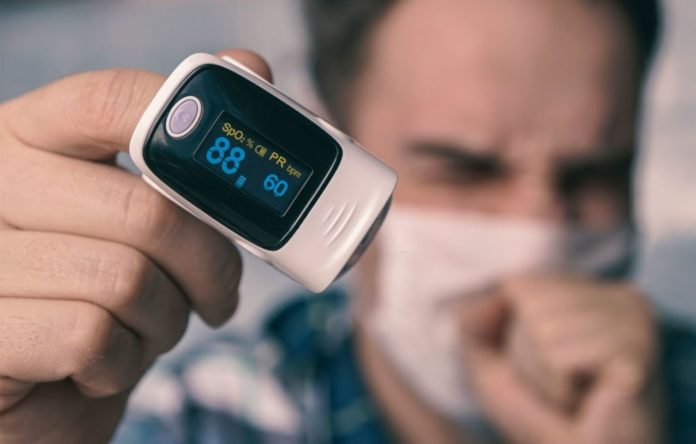Silent hypoxia is a condition in which the body’s oxygen levels are abnormally low, which can cause irreversible damage to essential organs if left untreated for too long.
Many aspects of how the novel coronavirus targets the lungs and other regions of the body remain a mystery to scientists. One of the most perplexing and life-threatening questions is how the virus induces “silent hypoxia,” a condition in which the body’s oxygen levels are abnormally low, causing irreversible damage to crucial organs if left untreated for too long.
Boston University biomedical engineers and researchers from the University of Vermont have begun to unravel the puzzle thanks to computer models and comparisons with real patient data.
Many individuals infected with severe COVID-19 show no symptoms of shortness of breath or difficulty breathing, despite dangerously low oxygen levels. Hypoxia was given the name “silent” because of its propensity to cause damage discreetly. The infection is thought to harm the lungs first in coronavirus sufferers, rendering parts of them unable to function properly. Those tissues run out of oxygen and stop operating, no longer supplying oxygen to the bloodstream, resulting in silent hypoxia. However, until today, it was unclear how the domino effect works.
“We didn’t know [how this] was physiologically possible,” said Bela Suk – one of the authors of the study.
Some covid patients have had blood oxygen levels that are “incompatible with life,” according to some researchers. Surprisingly, several of these patients’ lung tests revealed little to no abnormalities, according to Suki.
To figure out what causes silent hypoxia, BU biomedical engineers utilized computer modeling to evaluate three scenarios that explain how and why the lungs stop supplying oxygen to the bloodstream. According to biomedical engineer Jacob Herrmann, a research postdoctoral associate in Suki’s lab and the primary author of the new study, silent hypoxia is likely caused by a mix of biological mechanisms that may occur simultaneously in the lungs of COVID-19 patients.
Normally, the lungs execute the life-sustaining function of gas exchange, supplying oxygen to every cell in the body as we breathe in and expelling carbon dioxide. If the blood oxygen level drops below 92 percent, it’s cause for alarm, and a doctor may opt to intervene with supplemental oxygen. (When clinicians initially raised the alarm about silent hypoxia early in the coronavirus pandemic, oximeters raced off shop shelves as customers afraid that they or their family members might have to recover at home from milder instances of coronavirus wanted to be able to monitor their blood oxygen levels.)
The researchers initially investigated how COVID-19 affects the lungs’ ability to control blood flow. Normally, if regions of the lung aren’t getting enough oxygen due to infection, the blood veins in those places narrow. This is really a healthy thing for our lungs to accomplish, since it pushes blood to flow past oxygen-rich lung tissue, which is subsequently circulated throughout the rest of the body.
Preliminary clinical data, according to Herrmann, suggest that the lungs of some COVID-19 patients have lost their ability to restrict blood flow to already damaged tissue, and are instead potentially opening up those blood vessels even more — something that is difficult to see or measure on a CT scan.
Herrmann, Suki, and their colleagues tested this theory using a computational lung model, finding that for blood oxygen levels to drop to the levels seen in COVID-19 patients, blood flow would have to be much higher than normal in areas of the lungs that can no longer gather oxygen, contributing to low oxygen levels throughout the body.
The researchers then investigated how blood clotting might affect blood flow in various parts of the lung. When the lining of blood vessels becomes irritated as a result of COVID-19 infection, microscopic blood clots form inside the lungs that are too small to be visible on medical scans. They discovered using computer modeling of the lungs that this could produce quiet hypoxia, but that it is unlikely to be enough to cause oxygen levels to drop as low as those shown in patient data.
Finally, the researchers used their computer model to see if COVID-19 interferes with the usual air-to-blood flow ratio required for optimal lung function. According to Suki, this type of mismatched air-to-blood flow ratio occurs in many respiratory disorders, such as in asthma patients, and it could be a contributing factor to the severe, silent hypoxia seen in COVID-19 patients. Their models show that the mismatch must be occurring in areas of the lung that do not appear injured or abnormal on lung imaging if this is a cause of silent hypoxia.
Overall, their data show that a combination of all three factors is likely to be to blame for some COVID-19 patients’ severe episodes of low oxygen. Clinicians can make better decisions about how to treat patients using measures like ventilation and supplemental oxygen if they have a deeper grasp of the underlying mechanisms and how the combinations can vary from patient to patient. A number of therapies are presently being investigated, including prone posture, a low-tech technique that rolls patients over onto their stomachs, allowing the back half of the lungs to suck in more oxygen and balancing the air-to-blood ratio.
“Different people respond to this virus so differently,” added Suki.
He believes it’s vital for clinicians to understand all of the probable reasons why a patient’s blood oxygen level is low so they can choose the best treatment, which could include drugs to constrict blood vessels, break up blood clots, or rectify a mismatched air-to-blood flow ratio.
Image Credit: iStock
You were reading: Silent Hypoxia: This is how SARS-COV-2 triggers low blood oxygen in COVID-19 patients
